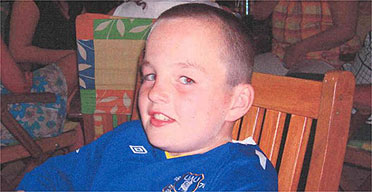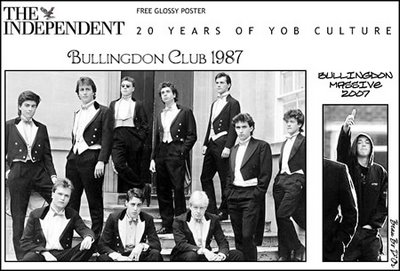 (This is mostly going to be a tedious post based around the premise that despite all the claims that zero tolerance has worked in New York and Los Angeles, the cities are in fact more dangerous than London is. If you don't want to read me ranting about overreactions to one heinous crime, skip it.)
(This is mostly going to be a tedious post based around the premise that despite all the claims that zero tolerance has worked in New York and Los Angeles, the cities are in fact more dangerous than London is. If you don't want to read me ranting about overreactions to one heinous crime, skip it.)
Which side are you on? Is this what it comes down to? Must we be polarised between the Sun's call for the murder of Rhys Jones to "change us as a nation" and the Grauniad's that this is not a country "beset by universal violence or disorder, or even, in most parts of the country, by rising levels of criminality"? The answer, as usual, is somewhat in-between. It's incredibly easy to pick major holes in almost every Sun leader, as regular readers will know, so I'm not going to bother doing that today, although I will say that I at least agree with its sentiments on education, although it doesn't so much as mention poverty, both in terms of wealth and ambition, especially when these gangs see the alternative ways of earning respect as the way to make up for both. Community solidarity, which it does at least mention, although it doesn't look at the reasons why it's broken down, is also vital.
While most on the left side of the political fence will nod along with the lack of urgency and appeal for calm which emanates from the Guardian leader, the very last thing we should be is complacent. For too long Labour and much of the left has taken the poor for granted, regarding their votes as already earned and ignoring the very real problems which have emerged on the so-called "sink estates". Labour's answer, instead of really listening, both to those caught in the crossfire as it were and to both the victims and the perpetrators has been to dish out ASBOs and legislate, rather than examine why things are as they are, or in fact afraid to find out what they are. As Justin points out, for too long we've allowed idiots to rule the roost in some of these communities while everyone else has suffered in silence, either out of want of a quiet life or fear, when what's really needed is for them to be ridiculed as the little men they are. If this involves a certain amount of humiliation, so be it. At the same time, we should also recognise that some of the lower-level trouble is just a teenage stage, which in some children is a lot more serious than it is with others. Not every teenage occasional hooligan or "yob" turns into an adult with those same tendencies.
The key to tackling it though is in intervening early, in firm parenting rather than the blaming of everything and everyone else that some indulge in, and understanding the desperation that often underpins such an existence. In our little world of pseudo-individualism, where capitalism is the solution to everything, and we only need to send in the voluntary organisations and the entrepreneurs for all to be made right, we have to accept that the concept of wage slavery, which a lot of those involved in low-level yobbery will have the rest of their lives to look forward to is not much of a fairytale existence. There is no simple solution, but the much mocked SureStart centres deserve both more funding and more time to make a difference, local government and accountability have to be strengthened, and most of all, we shouldn't knee-jerk into yet another punitive, draconian crackdown.
Which, naturally, is just what the Sun is saying must happen. Like two days again when David Cameron brought up New York, the paper is calling for zero tolerance, like that introduced by the police chief Bill Bratton in that city and now in Los Angeles. He's even talked to the paper saying that it's exactly what's needed here.
There are a number of problems with this. Firstly, Bratton's experiment has not just involved pumping in police and implementing ridiculously harsh punishments in some cases, but also the COMPSTAT system, used to break down where crime has occurred over the past week so that task forces, more patrols and further measures can be brought into those areas. This is all very well for a city force, but to do it across a whole country, especially when a decent amount of areas of it have no such problems and crime is something the residents read about in the paper, is not just untested, it's the old cliche of using a sledgehammer to crack a nut.
Secondly, we have to examine the actual figures to see just how safe Los Angeles and New York are. It's impossible to compare either to England and Wales entirely due to the vast difference in overall population, but we can reasonably well apply the crime levels in both to that in London. The Sun produces a load of figures showing how crime has dropped in both under Bratton's watch, but by just how much in comparison to our own major city?
On the face of it, the LA figures (PDF) do indeed look good. In all areas, apart from homicide, where LA had 481 last year and London (PDF) had 165, it looks as if LA has less rapes, less robbery and much fewer burglaries. The only problem with all that is that LA, according to the COMPSTAT weekly figures (PDF), has a population of just over 4 million. London, however, has a metropolitan population of between 12 and 14 million, which means we're going to have to multiply the LA figures by three to make them applicable. LA then has just under 600 more rapes than in London, 2,709 to 2,094, robberies are around the same with 42,975 in LA to 43,971 London, burglaries similarly go to 60,060 in LA to 59,285 in London. LA counts theft from vehicles and vehicle theft separately, so when added together and multiplied by 3 hits 163,494 compared to London's vehicle crime figure of 125,234.
New York, with a population of around 19 million, is more broadly comparable with London's, so I'm just going to do them side by side, but if you're anal enough you can ratchet the London figures up accordingly. New York had 874 murders in 2005; London had 165 last year. Rapes in NY were at 3,636, London at 2,094, NY experienced 35,179 robberies, while London had 43,971, and NY had 68,034 burglaries whilst London had 59,285. There are no instantly comparable figures on aggravated assaults, but for comparisons sake lists 46,150, while London records 4,810 instances of grievous bodily harm.
Does this actually tell us anything? Well, when it comes down to what most occupies the media, the murders and rape, both New York and Los Angeles are on this data far more dangerous places to live. Indeed, both have more murders than England and Wales have as a whole (There were 765 in 2005, including the 52 victims of 7/7). On the other instances of more minor crime, the figures are broadly comparable. While New York and Los Angeles have had zero tolerance, the numbers in London have been falling without any such heavy-handed intervention.
This isn't to deny that it's possible that zero tolerance here could bring crime down further than it already is. Both the BCS and the police figures have shown a major drop in most crime, with the chances of being a victim the lowest for a generation. They've also broadly either stayed static or dropped for the past 10 years. Whether you want to link this to New Labour's crackdown is up to you. What it doesn't show however is that there is a major need for the zero tolerance approach. If we were to go down that road, it would require a major step change in our current thinking on the criminal justice system. More prisons would need to be built, we would have to accept much harsher sentences for what we now regard as "minor" crime, and we would also have to reconsider the role of rehabilitation as a whole. The reality is that we should be making policy on what works, not on what's either liberal or punitive respectably, and if there's one thing we do know, it's that prison doesn't work. The time for zero tolerance has not yet come, if it ever will.Labels: crime figures, gun crime, Rhys Jones, Scum-watch, Sun-watch, youth crime, zero tolerance




